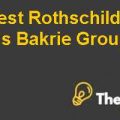
Decision as per Honorable William B. Chandler III in the Delaware Court of Chancery
FACTS PRESENT AS PER THE CASE
Dow in 2008 was the world's largest producer of polyethylene and polystyrene resins. It was founded in 1897 by Herbert Dow as a manufacturer of commercial bleach. In 1900 the company was merged with Midland Chemical in and moved into agricultural and food products. It was a Fortune 200 firm that paid dividend for 388 consecutive quarters. From 1983 to 2007 Dow divested 166 businesses, acquired 95 businesses and took stake in another 58 companies. Andrew Liveris became CEO of Dow in Nov 2004. He announced the "Dow of Tomorrow" a strategy to focus of growth and profitability. The strategy consisted of two parts: pursuing a minimal asset base of the business and focus on high growth, margins and earnings to remove the seasonal effect.
For the implementation of the first part of the strategy, Dow entered into a JV with a subsidiary of Kuwait Petroleum Corporation KPC and known as the K-Dow chemical’s which was a state-owned holding company. MOU was signed in Dec 07; this deal was supposed to bring $7.2 billion of cash after tax.
The second part of the strategy was to become a producer of specialty chemicals and advanced materials for which Dow agreed to acquire Rohm and Haas.
Raj Gupta, the CEO of Haas was instructed by the Haas family whose 45 people owned 32% of the company's shares that they wanted to sell their stake in the company.
Dow was able to negotiate a deal with Haas as its bid price of $78 prevailed; the payment was made as of $15.3 billion in cash and would assume $3.5 billion in debt for the deal of $18.8 billion.
Liveris described Rohm as a beachfront property and this deal as a Jewel. He also described that there are not many deals such as these in the market. CFO of Dow Geoffery Merszei was also very excited about the Rohm deal as he knew that this deal would bring value creation and growth synergies.
To finance the deal Dow had planned to issue $3 billion of 8.5% convertibles preferred equity and an additional $1 billion to Kuwait’s sovereign wealth fund. In addition to that, a one year $13 billion bridge loan was set up by a 19-bank consortium organized through Citigroup, Merrill Lynch and Morgan Stanley.
From this deal 500 Rohm executives would have received $375 million for their stocks and options. Gupta, the CEO would alone receive $100 million.
With the implications of the economic downturn on 29 Nov 2008, Dow and PIC signed the K-Dow JV agreement but with revised terms. However, 4 weeks later PIC unilaterally terminated the contract, making them liable for only $2.5 million towards Dow if the deal was not closed. Dow share price took a very negative impact and its rating reduced to BBB, which was slightly above Junk status.
With everything finalized among Dow and Rohm and the final approval of European Commission Dow, the deal had to close in 2 week, otherwise $3 million of surcharge would have to pay for everyday above the 2 weeks. “Ticketing Fees”
With only 2 days remaining for the closure of the deal, Dow dismissed the acquisition stating that there had been material adverse change and unveiled its intention of not pursuing the acquisition any further.
DELAWARE COURTS OPTIONS
The court had 3 options in regard of this case, either to enforce Dow Chemical’s to go ahead with this acquisition on the agreed price of $78/share, to make Dow and Rohm re-negotiate the merger taking in consideration the current economic conditions and finally to let Dow back out of the acquisition as well as pay a penalty for the termination of the acquisition.
William B. Chandler III Decision
It is evident from the facts of the case that Dow was too eager to enter in this contract with Rohm in order to create synergies as it has done in the past. Since, Rohm was the strategically correct acquisition for Dow; hence they did not consider any situation where they might have to withdraw from this acquisition, which did not let them to include Material Adverse Change clause in their contract. This suggests that no matter Material Adverse Changes were there in the environment, still there would be no changes and the acquisition would proceed as per the contract and the Delaware Chancery Court was proud over itself on providing clarity and predictability in decision and was not moved by any particular factual situation to bend or change the law. A precedent had already been set in the case of Hexion-Huntsman Chemicals where Judge Lamb from the Delaware Court of Chanceryrejected the MAC claim, as a company consideration of acquisition of another company is not a single......................
This is just a sample partial case solution. Please place the order on the website to order your own originally done case solution.













